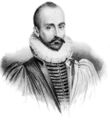Template:Selected anniversaries/September 13: Difference between revisions
No edit summary |
No edit summary |
||
| (2 intermediate revisions by the same user not shown) | |||
| Line 1: | Line 1: | ||
<gallery> | <gallery> | ||
File:Michel de Montaigne.jpg|link=Michel de Montaigne (nonfiction)|1592: Philosopher and author [[Michel de Montaigne (nonfiction)|Michel de Montaigne]] dies. He was one of the most significant philosophers of the French Renaissance, known for popularizing the essay as a literary genre. | File:Michel de Montaigne.jpg|link=Michel de Montaigne (nonfiction)|1592: Philosopher and author [[Michel de Montaigne (nonfiction)|Michel de Montaigne]] dies. He was one of the most significant philosophers of the French Renaissance, known for popularizing the essay as a literary genre. | ||
||1755: Oliver Evans born ... inventor, engineer and businessman born in rural Delaware and later rooted commercially in Philadelphia. He was one of the first Americans building steam engines and an advocate of high pressure steam (vs. low pressure steam). A pioneer in the fields of automation, materials handling and steam power, Evans was one of the most prolific and influential inventors in the early years of the United States. Pic. | ||1755: Oliver Evans born ... inventor, engineer and businessman born in rural Delaware and later rooted commercially in Philadelphia. He was one of the first Americans building steam engines and an advocate of high pressure steam (vs. low pressure steam). A pioneer in the fields of automation, materials handling and steam power, Evans was one of the most prolific and influential inventors in the early years of the United States. Pic. | ||
| Line 29: | Line 27: | ||
File:Hannibal Goodwin.jpg|link=Hannibal Goodwin (nonfiction)|1898: Priest and inventor [[Hannibal Goodwin (nonfiction)|Hannibal Goodwin]] patents celluloid photographic film. | File:Hannibal Goodwin.jpg|link=Hannibal Goodwin (nonfiction)|1898: Priest and inventor [[Hannibal Goodwin (nonfiction)|Hannibal Goodwin]] patents celluloid photographic film. | ||
||1905: Michael Willcox Perrin born ... scientist who created the first practical polythene, directed the first British atomic bomb programme, and participated in the Allied intelligence of the Nazi atomic bomb. Pic. | ||1905: Michael Willcox Perrin born ... scientist who created the first practical polythene, directed the first British atomic bomb programme, and participated in the Allied intelligence of the Nazi atomic bomb. Pic. | ||
| Line 51: | Line 47: | ||
||1956: The IBM 305 RAMAC is introduced, the first commercial computer to use disk storage. | ||1956: The IBM 305 RAMAC is introduced, the first commercial computer to use disk storage. | ||
||1959: The Soviet probe Luna 2 crashes onto the Moon, becoming the first man-made object to reach it. | |||
||1981: Gregory Breit dies ... physicist and academic. During the early stages of the war, Breit was chosen by Arthur Compton to supervise the early design of the first atomic bomb during an early phase in what would later become the Manhattan Project. Breit resigned his position in 1942, feeling that the work was going too slowly and that there had been security breaches on the project; his job went to Robert Oppenheimer, who was later appointed to scientific director of the entire project. Pic. | ||1981: Gregory Breit dies ... physicist and academic. During the early stages of the war, Breit was chosen by Arthur Compton to supervise the early design of the first atomic bomb during an early phase in what would later become the Manhattan Project. Breit resigned his position in 1942, feeling that the work was going too slowly and that there had been security breaches on the project; his job went to Robert Oppenheimer, who was later appointed to scientific director of the entire project. Pic. | ||
| Line 59: | Line 57: | ||
||2004: Chemist Luis E. Miramontes dies. He co-invented the progestin norethisterone, used in one of the first three oral contraceptives. Pic. | ||2004: Chemist Luis E. Miramontes dies. He co-invented the progestin norethisterone, used in one of the first three oral contraceptives. Pic. | ||
||2014: Matthew Sands dies ... physicist and educator best known as a co-author of the ''Feynman Lectures on Physics''. Pic. | ||2014: Matthew Sands dies ... physicist and educator best known as a co-author of the ''Feynman Lectures on Physics''. Pic. | ||
</gallery> | </gallery> | ||
Latest revision as of 12:56, 7 February 2022
1592: Philosopher and author Michel de Montaigne dies. He was one of the most significant philosophers of the French Renaissance, known for popularizing the essay as a literary genre.
1861: Mathematician Dmitry Mirimanoff born. In 1917, he will introduce the cumulative hierarchy of sets and the notion of von Neumann ordinals; although he will introduce a notion of regular (and well-founded set) he will not consider regularity as an axiom, but also explore what is now called non-well-founded set theory, and the idea of what is now called bisimulation.
1873: Mathematician and author Constantin Carathéodory born. He will pioneer the axiomatic formulation of thermodynamics along a purely geometrical approach.
1898: Priest and inventor Hannibal Goodwin patents celluloid photographic film.



